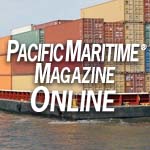The Port of Portland recently announced new business at Terminal 6, including an expansion of global shipping company SM Line with two more vessels per month; shipping company MSC’s plan to add another container service; and new private charter boats and domestic 53-foot containers.
The news comes a year-and-a-half after regular container service returned to the port for the first time in more than four years with the help of SM Line. Operations in Portland have been so successful that SM Line is now starting a new intermodal rail service this year with Union Pacific bound for Chicago and adding loader ships every other week for local containers.
“Portland is an important strategic port for our company, constantly pioneering new markets,” SM Line Managing Director Kwang Kuk Choi remarked. “SM Line will develop and provide competitive logistics solutions that cover both the sea and inland through partnership with the Port of Portland.”
Meanwhile, MSC will begin making stops in Portland this month with its Santana route, which makes Portland its first port of call, and also stops in Yantian, Shanghai and Tacoma.
“MSC has the largest container fleet to ever come to Portland and marks only the second time in nearly 15 years that the port has secured a second weekly transpacific partner,” the port said in a statement.
Portland also said that it’s seeing more one-off vessel calls because of cargo congestion at other ports. As a result, shippers are bringing charter vessels filled with goods to Terminal 6.
Eight ships carrying 53-foot domestic containers are set to visit the terminal through 2022.
And over the summer, BNSF inked a one-year agreement to process intermodal cargo between Seattle, Tacoma and Terminal 6.
“Terminal 6 is productive and busy at a time of economic recovery that is so important to our regional economy,” Port of Portland Chief Operating Officer Dan Pippenger said. “That wouldn’t have been possible without SM Line committing to the Portland market and the hard work of all the workers on site.”
“In the last year, longshore workers endured a pandemic, an unprecedented wildfire season and snowstorms – and through it all, they kept goods and products moving in and out of the region,” Pippenger continued. “While these new services won’t solve supply chain issues overnight, they will help local businesses find alternative shipping options in our region.”

